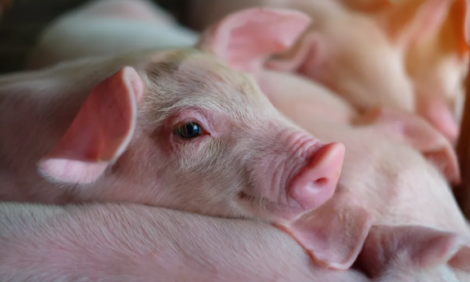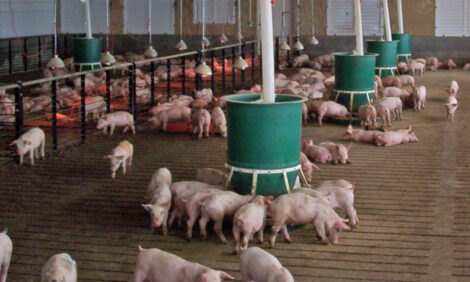



US Pork Outlook Report - July 2005
By U.S.D.A., Economic Research Service - This article is an extract from the July 2005: Livestock, Dairy and Poultry Outlook Report, highlighting Global Pork Industry data.
The U.S. pork sector can increase pork production in four ways:
They can increase the U.S. breeding herd, increase the breeding herd’s
productivity, feed hogs to heavier weights, and increase imports of live
Canadian swine. In the past, producers relied mostly on increases in
breeding herd numbers to increase production.
The June Quarterly Hogs and Pigs report highlights the current industry practice of
smaller changes in breeding herd numbers and larger productivity gains. Heavier
slaughter weights and Canadian live imports are also contributing to expected
production increases in 2005 and 2006.
Quarterly Hogs and Pigs Shows Modest Breeding Increases
The information reported in the Quarterly Hogs and Pigs for June 1 suggests that
the U.S. pork industry plans to increase pork production by modestly expanding
breeding herd numbers. The June 1 inventory of animals kept for breeding showed
a 1-percent increase over June 2004. Expansionary effects of the larger breeding
herd appear to be tempered by a steady, rather than an aggressive breeding program.
Second-half farrowing intentions indicate that producers intend to farrow about the
same number of females in the June-November period of this year as they did in the
second half of last year.
The report provides more evidence that increases in breeding herd productivity,
rather than increases in breeding animal numbers alone, are an increasingly
important means of expanding U.S. pork production. For all U.S. hog operations,
the number of pigs per litter has increased from 8.28 in 1995, to 8.98 for the first
half of 2005, an increase of more than 8 percent.
Increasingly productive breeding herds, together with heavier average dressed
weights and imported Canadian feeder pigs and slaughter hogs, contribute to
increases in U.S. commercial pork production, as U.S. breeding herd numbers trend
lower over the long term.
|
December-May pigs per litter, 1995-2005

|
|
June 1 inventory of breeding animals versus commercial pork production, 1995-2005

|
U.S. pork production in 2005 is expected to be 20.8 billion pounds, 1.6 percent above production in 2004. Next year, production is expected to increase 1.4 percent to 21.1 billion pounds. The June price of 51-52 percent live equivalent hogs was $49.86 per cwt, 14 percent lower than a year ago. Second-quarter prices were $52.09 per cwt, about 5 percent lower than the second quarter last year. For 2005, hog prices are expected to range between $47 and $49 per cwt. Prices next year are expected to be somewhat lower, but above most producers’ breakeven, ranging between $43 and $47 per cwt.
Wholesale Pork Prices Weaken; Second Quarter Retail Prices Higher
The pork carcass cutout is an estimate of the value of a 51-52 percent lean 185-
pound hog carcass, based on current wholesale prices being paid for sub-primal
pork cuts. The cutout provides an indication of the overall supply and demand
situation of the wholesale pork cuts market. For June 2005, the weekly cutout
averaged $66.45, almost 18 percent lower than the same period last year. The lower
cutout value likely reflects weaker domestic pork demand and large cold storage
stocks of several pork cuts.
Although the June Cold Storage report
(http://usda.mannlib.cornell.edu/reports/nassr /other/pcs-bb/2005/), showed that
stocks of pork cuts declined 9 percent from May levels, large stocks of bellies, ribs,
and boneless loins held total pork stocks 24 percent higher than in June 2004. Cold
stocks of pork at the end of May remained above the 3-year average level.
|
Composite pork carcass cutout

|
|
Ending stocks: Total frozen pork

|
Despite indications of wholesale pork market weakness, second-quarter retail prices for pork, at $2.87 per pound, were 4 percent higher than the same period last year. Higher retail pork prices were likely not an indication of significant supply deficits. It is more likely that some retailers set retail pork prices in relation to beef prices. Second-quarter retail beef prices were more than 3 percent higher than a year ago.
USDA Increases Forecasts for 2005 Pork Exports, Lowers Imports
Exporters are expected to ship more than 2.6 billion pounds of U.S. pork products
to foreign markets in 2005, more than 21 percent higher than exports last year.
Trade restrictions on North American beef and poultry disease concerns in Asia has
created significant protein deficits. In addition to trade restrictions in Asia, the low valued
U.S. dollar, together with relatively strong economic growth rates in porkimporting
countries will likely continue to make U.S. pork particularly attractive in
such markets as Mexico, Romania, Russia, as well as in Asia.
On the other hand, the lower valued U.S. dollar makes imported pork products more
expensive, and is likely to induce U.S. importers to buy less pork from major import
suppliers in Canada and Denmark, both this year and in 2006. The United States is
expected to import 980 million pounds of pork products in 2005, almost 11 percent
less than in 2004. Imports should decline again in 2006, to 960 million pounds.
Mexican Antidumping Claim
An Evaluation of Mexican Antidumping Claim Against U.S. “Pork Legs”
On May 31, 2004, the Mexican Secretariat of Economy (SE) announced the
initiation of an official antidumping investigation against U.S. “pork legs”, products
classified in tariff codes 0203.12.01 and 0203.22.01. The investigation was selfinitiated
by SE after obtaining sufficient market information to allege damage to the
domestic pork industry from pork legs exported by the United States in 2003, thus
meriting a dumping investigation.
(http://www.fas.usda.gov/gainfiles/200406/146106581.pdf)
Dumping can be defined in two ways: selling at below production costs, and selling
internationally at less than the domestic price. It is difficult to evaluate the Mexican
claim with respect to the first definition because of the proprietary nature of U.S.
processors’ costs. However, information with respect to the value of Mexican
imports of U.S. “pork legs” is available, as are U.S. prices of roughly the same pork
products. Graphing the 2003 data show that the monthly value of Mexican imports
of “pork legs” exceeded the domestic U.S. price of comparable pork products. The
data show that U.S. “pork legs” were not dumped under the definition of selling
internationally at values less than domestic prices.
|
Comparison of value of Mexican imports of U.S. "pork legs" and domestic price of U.S. fresh hams, 2003

|
Links
For more information view the full Livestock, Dairy and Poultry Outlook - July 2005 (pdf)Source: Livestock, Dairy and Poultry Outlook - U.S. Department of Agriculture, Economic Research Service - July 2005








